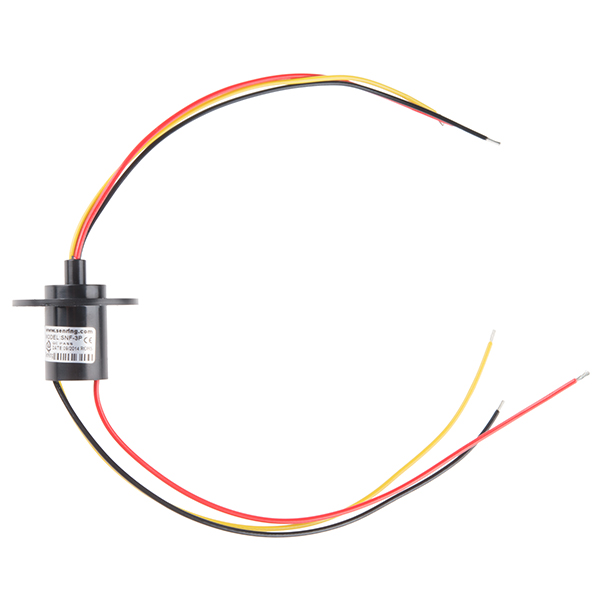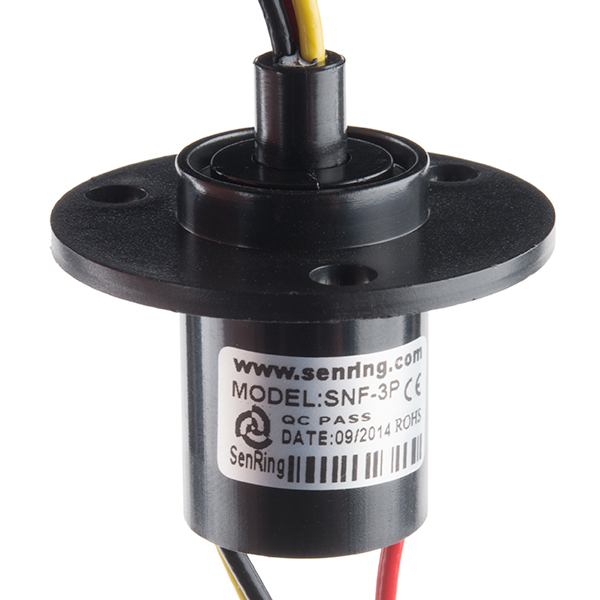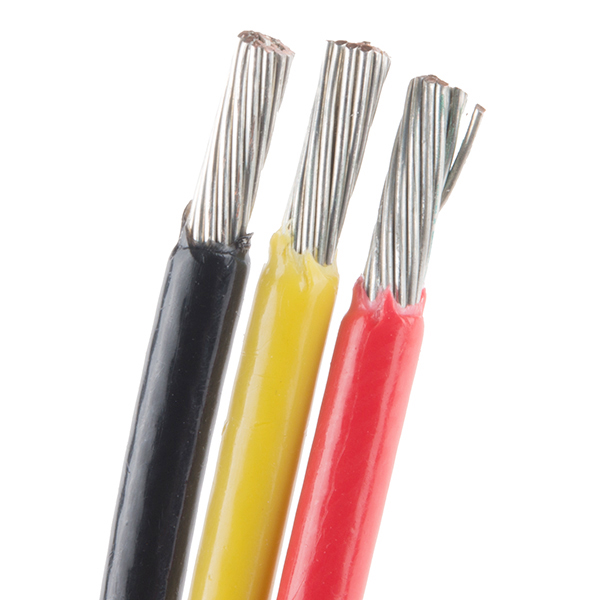This is a 3 wire slip ring, a remarkably simple electromechanical assembly that allows for electronic signals and power to be passed through its rotating innards. Commonly, you'd find slip rings in wind turbines, radar antennae, or anything else that requires continuous 360° rotation while maintaining an electrical connection. This particular slip ring provides you with a compact body with precious metal alloy fiber brush to silver plated ring contacts inside. We like using these slip rings to specifically transfer power in our spinning projects because regardless of the wires position in its rotation the power remains consistent!
Each slip ring is capable of handling a continuous working speed of 250RPM, a current rating of (a whopping) 10A, and an operating voltage of 380VDC/AC. We aren't kidding about how compact this little guy is, with only and outer diameter of 22mm for the body an 44mm diameter flange, you should have no issues fitting these into your next project. Additionally, the 250mm stranded wires protruding from each side of the slip ring have a thickness of 16AWG while the whole assembly has a water protection rating of IP51.
Note: We have used these Slip Rings at 15A with no issue.
- 3 wires
- Voltage: 380VDC/AC
- Current Rating: 10A
- Max Current Rating: 25A
- Operating Speed: 250RPM
- Compatible with data bus protocols
- Transfers analog and digital signals
- 22mm Diameter x 33mm Length w/ 44mm Diameter Flange
Slip Ring - 3 Wire (10A) Product Help and Resources
**Slip Ring in continuous rotation camera**
For whose who have seen the video, and want to recreate Nick's camera rig, or something like it, here is the parts list, and how they're attached. The full rig
ROB-12433 screws onto the camera mount with a bolt and washer
2x ROB-13139 1/2" standoff for USB BOB
ROB-12505 holds camera and USB BOB
2x ROB-131391/2" standoff under plate, all attached to
ROB-12209, the pulley, on
ROB-12414 clamped onto a 2" long, 1" diameter tube going through
ROB-12282, the bearing block.
ROB-13064, the slip ring fits inside the tube, with the narrow end going into
ROB-12214, which attaches to
ROB-12122, the base
ROB-12282, the bearing block mentioned before, attaches to
ROB-12287 with washers, then to
4xROB-12247 standoffs, on
ROB-12122, the base
ROB-12209, the large pulley from before connects with
ROB-12116, the smooth belt, to
ROB-12523, the hub mount pulley, which mounts on ROB-12347, the servo kit, which mounts on ROB-09347, the servo. 4x ROB-12286, standoffs attach the servo kit to ROB-12122, the base
All held together with machine screws in two lengths as needed, ROB-12525 ROB-12485
Reference Photos
Core Skill: Robotics
This skill concerns mechanical and robotics knowledge. You may need to know how mechanical parts interact, how motors work, or how to use motor drivers and controllers.
Skill Level: Noob - You will be required to put together a robotics kit. Necessary parts are included and steps will be easy to follow. You also might encounter basic robotics components like bearings, mounts, or other hardware and need a general idea of how it goes together.
See all skill levels
Core Skill: Electrical Prototyping
If it requires power, you need to know how much, what all the pins do, and how to hook it up. You may need to reference datasheets, schematics, and know the ins and outs of electronics.
Skill Level: Competent - You will be required to reference a datasheet or schematic to know how to use a component. Your knowledge of a datasheet will only require basic features like power requirements, pinouts, or communications type. Also, you may need a power supply that?s greater than 12V or more than 1A worth of current.
See all skill levels
Comments
Looking for answers to technical questions?
We welcome your comments and suggestions below. However, if you are looking for solutions to technical questions please see our Technical Assistance page.
Customer Reviews
4.5 out of 5
Based on 2 ratings:
Nice way to de-couple power on a droid
Smooth and heavy gage wire. Easy to mount and effectively decouples power to a rotating member on a droid. Fast delivery from Sparkfun too.
Electrical slip ring
Easy to work with design and operation. Inexpensive compared to other alternatives. Bottom line - nice product.




How much load can the ring handle? I'm looking to build a hanging, rotating light fixture.
Can anyone point me to a tutorial that shows how to connect one of these slip rings with a servo motor to spin a platter containing some electronics? I'm not seeing how to connect the servo to the slip ring and how to firmly connect a spinning platter to the stub of the slip ring? Thanks!!
What sort of noise can be expected as the device rotates - could you run an i2c connection over this and expect clean communication?
The 6-wire and 12-wire units say they are good for use with digital protocols like Ethernet, CAN, etc.
Love the 15A rating, but would like to have two data lines...for RS-485 or other two-wire busses. Some slip rings are made with mixed gauge wires, ie. two 2A lines for data, and two 15A lines for power. Pretty please?!